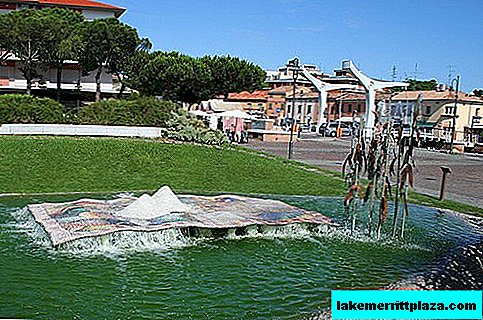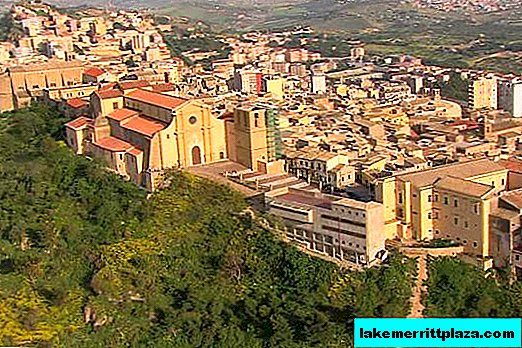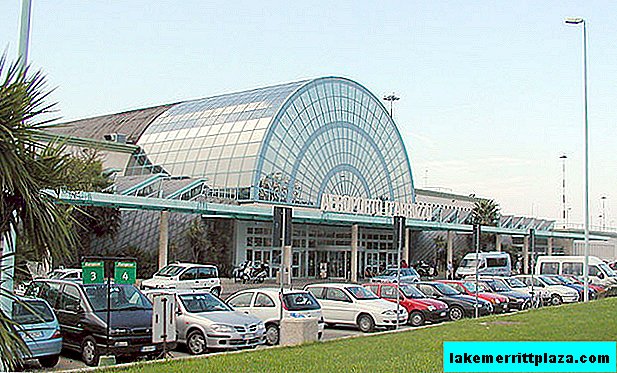This time we will again talk about the Italian product, which is firmly rooted in domestic tables. Salami (Salame) - a kind of hard sausage with bacon, appreciated throughout the world. Once in Italy, only privileged classes of the population enjoyed it. Today, almost everyone can afford salami at least for a holiday. "Two pieces of sausage on your table!" - sung in the popular song of the 90s. But we will not tell you fairy tales as the hero of the hit, but present the most true story about salami.
IGP and DOP grades
Many people love salami, and therefore they release it in most civilized countries of the world. But, as you know, sausage sausage is different, and in order to appreciate the original taste, you definitely need to go to its homeland - to Italy. The republic also has a huge number of manufacturers. However, only some products have been awarded special marks - IGP or DOP categories. These abbreviations in the name indicate the devotion to the tradition of manufacture and the high quality of Italian salami.
Salama da sugo igp

Salami da sugo - sausage, typical of the province of Ferrara (Ferrara), but completely unusual in appearance. It consists of pork meat, tongue and liver, wine, salt and spices (nutmeg, cloves, cinnamon, pepper). It has the shape of a melon and is tied with twine. It can be covered with a bloom of white mold, which appears naturally during ripening. Head weights range from 0.7 to 1.4 kg. The color is dark brown, the aroma is intense, the structure is soft and grainy. The minimum exposure period is 6 months.
The peculiarity of salami and sugo is that before use, it is most often prepared additionally. Soak in cold water to soften the coating, gently wash with brushes, and then cook for at least 4 hours. It is important that the sausage skin is not damaged. The finished product is eaten warm with mashed potatoes or pumpkin, cut into portions.
Salame cremona igp
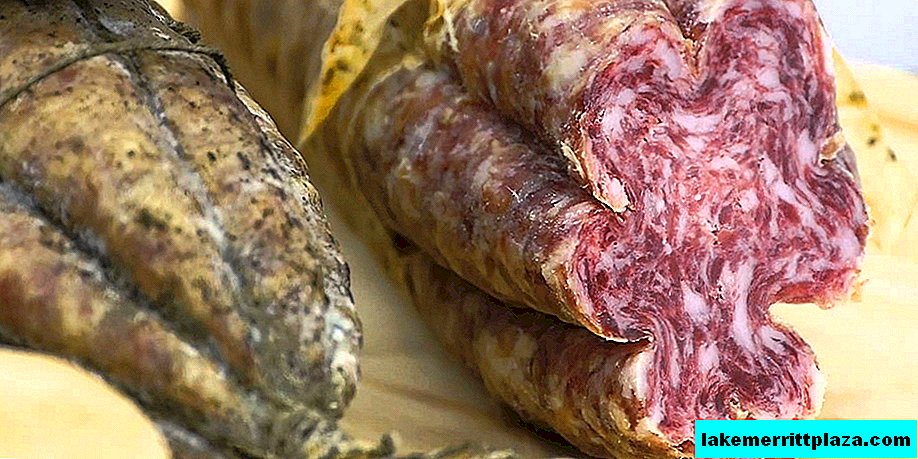
Cremona salami is made from pig meat grown in the production area of Parma ham (Prosciutto di Parma) and Prosciutto di San Daniele (Prosciutto di San Daniele). It is a mixture of fresh pork with salt and crushed garlic, seasoned in the intestines of pigs, cattle, sheep or horses.
Ripening period from 5 weeks to more than 4 months. Salami has the shape of a cylinder with a diameter of 65 mm and a length of 150 mm. The weight of the finished product is 500 g. The sausage is gently cut even after a long exposure. The color is intensely red, the aroma is saturated, the taste is spicy. Cremona goes well with vegetables, fruits, bread and cheeses.
Salame d'Oca di Mortara IGP

Salami di Mortara is made in the province of Pavia. It is made from pork and goose meat. Geese in the last 3 months of life should eat exclusively green food and grain and weigh at least 4 kg before slaughter. The goose skin serves as a casing for sausages. The texture is homogeneous, does not crumble. The color of the cut is dark red with a splash of fat. The smell is spicy, the taste is delicate and soft. The size of the sausage ranges from 0.3 to 4 kg. Salami di Mortara goes well with fresh and stewed vegetables.
Salame Sant'Angelo IGP

Salami Sant'Angelo is a sausage made from pig meat grown in the territory of Nebrodi. It has an elongated cylindrical shape and a natural white coating. The texture is delicate and compact. The color of the meat is ruby red, the fat is white. The smell is delicate, the taste is spicy, aromatic, obtained due to the special microclimate of the valley. The exposure time ranges from 30 to 90 days. The sizes of fat inclusions are larger in comparison with other varieties. Salami Sant'Angelo is eaten as an appetizer or aperitif for liquors.
Salame Felino IGP
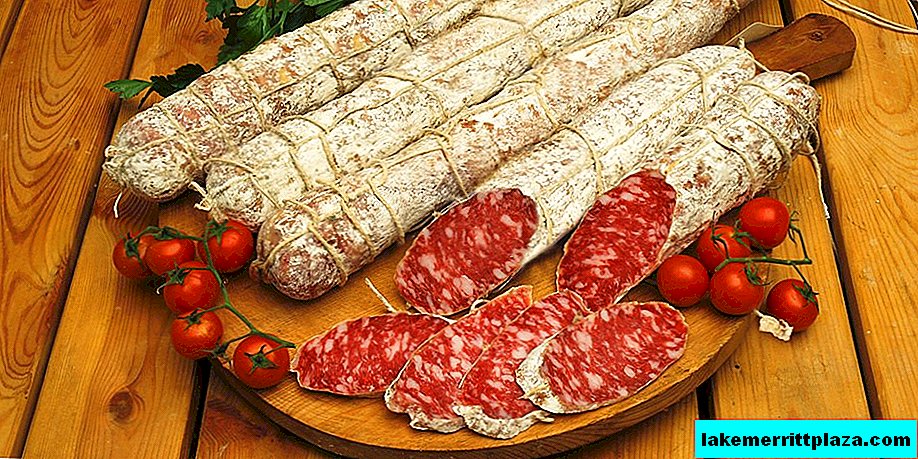
Salami Felino is a product from the city of the same name in the province of Parma. The composition of the sausage in addition to meat and spices includes dry white wine, which distinguishes it from other varieties. The weight of the sausage stick varies from 0.2 to 4.5 kg, the shape is cylindrical. The texture is compact, not elastic. The color is ruby red. The aroma is delicate, the taste is sweet. The minimum ripening time is 25 days. For consumption, the size of the slices is very important. Traditionally, slicing felino salami is quite thick (7 mm) and long (cut diagonally). It is served in combination with bread and Parma ham.
Salame piemonte igp
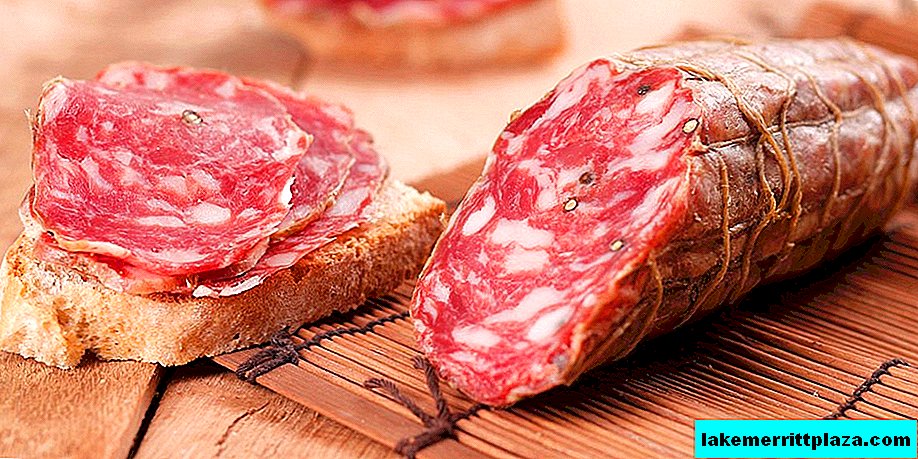
The production area of Salami Piedmont is limited to the territory of the region of the same name. In addition to seasonings, sausage is flavored with red wines from Piedmont from Nebiollo, Barbera and Dolcetto grapes. The salami stick has a cylindrical shape and weighs at least 300 g. The cut is ruby red, the texture is compact and uniform with interspersed fat and grains of pepper. The taste is sweet and delicate due to the short exposure (10-50 days depending on weight). Piedmont's salami is characterized by the aroma of aged wine and garlic. Cut it immediately before serving. Use with fresh bread, mustard, cheeses and salads. Also, sausage is served with various cereals and mashed potatoes.
Salame di Varzi DOP

Salami di Vartsi is from the municipality of Vartsi in the province of Pavia. Sausage is a mixture of fresh meat and coarse fat. The fat content is approximately 30-33% of the total weight of the product. The shape of the product is cylindrical, the cut color is bright red with white splashes of fat. The consistency is elastic, the texture is compact. The exposure time depends on the weight and variety: Varzi-Filzetta (0.5-0.7 kg, aging 45 days), Varzi-Filzettone (0.5-1 kg, aging 60 days), Varzi-Sottocrespone (1-2 kg , ripening 120 days), Varzi-Cucito (1-2 kg, ripening 180 days). The taste is sweet and delicate. Salami di Varzi is cut into thick slices and complemented with vegetable salads with vegetable oil, cheeses and wines.
Salame Brianza DOP
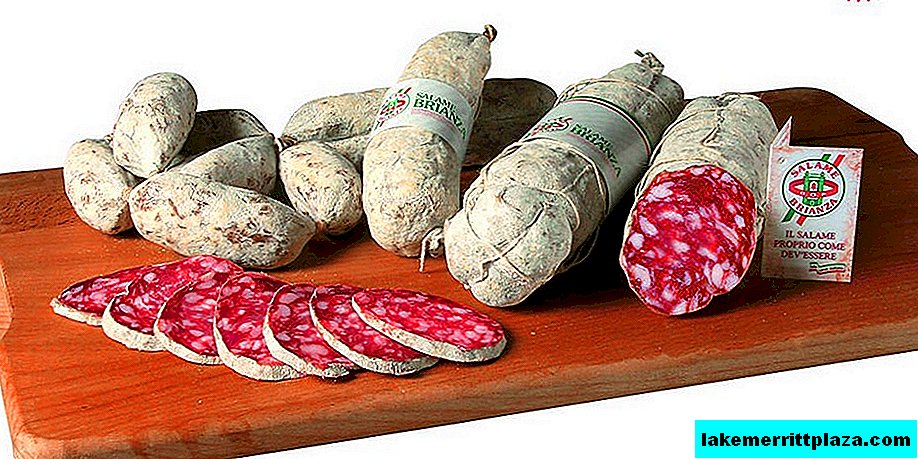
Brianza salami is produced from pig meat grown in the regions of Emilia-Romagna, Lombardia and Piedmont. In addition to salt, pepper, garlic and wine, sugar is allowed to be added to the product. The shape is cylindrical, the consistency is compact and not elastic. The cut color is ruby red. The smell is delicate, the taste is very sweet. Ripening time depends on the size and varies from 15 days to more than 5 months. Brianza salami is served as an appetizer for alcoholic beverages. It is used in many recipes.

For example, the salad we call Olivier is called the Russian Salad (Insalata Russa) in Italy and put salami in it.
Salame Piacentino DOP
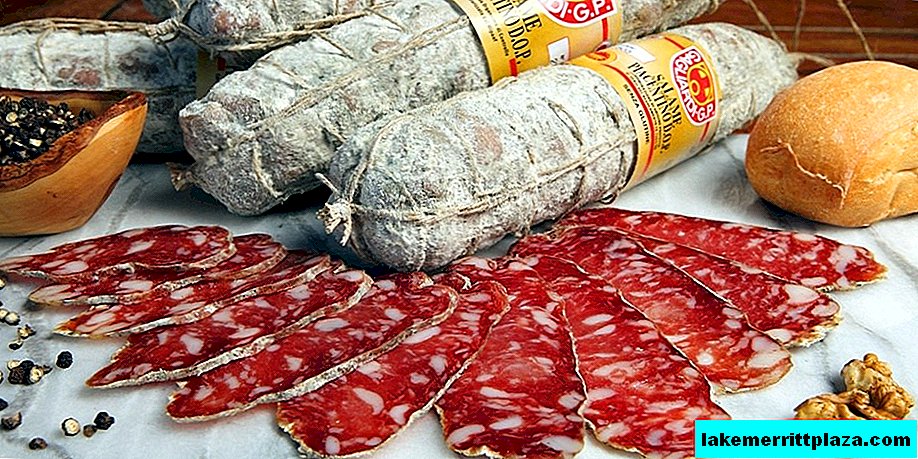
Piacentino salami is made from pig meat and fat in the province of Piacenza. The fat content is from 10 to 30%. The finished product has a cylindrical shape and weighs from 400 g to 1 kg. The texture is compact. The color of the cut is bright red with clearly distinguishable inclusions of fat. The smell is characterized by a delicate aroma of meat with a slight hint of spices. The taste is delicate, almost unsweetened, more intense with age. Exposure depends on weight and is at least 45 days. Piacentino salami is eaten as a snack and used in recipes.
Salamini Italiani alla Cacciatora DOP

Italian salami Cacciatore is produced in 11 regions of Italy.
Its name translates as "hunter." This is due to the tradition of people hunting salami for a snack.
Sausage differs from other varieties with a rich history. The product is cylindrical in shape, about 20 cm long and 6 cm in diameter. It weighs an average of 350 g. The texture is dense and not elastic. The cut is ruby red with evenly distributed grains of fat. The aroma is delicate, the taste is sweet and delicate without sourness. The minimum ripening time is 10 days. Cachiatore is eaten with unsalted bread, supplemented with good sparkling wine, cheeses, fruits and vegetables. Fits perfectly in salads.
Salame di milano
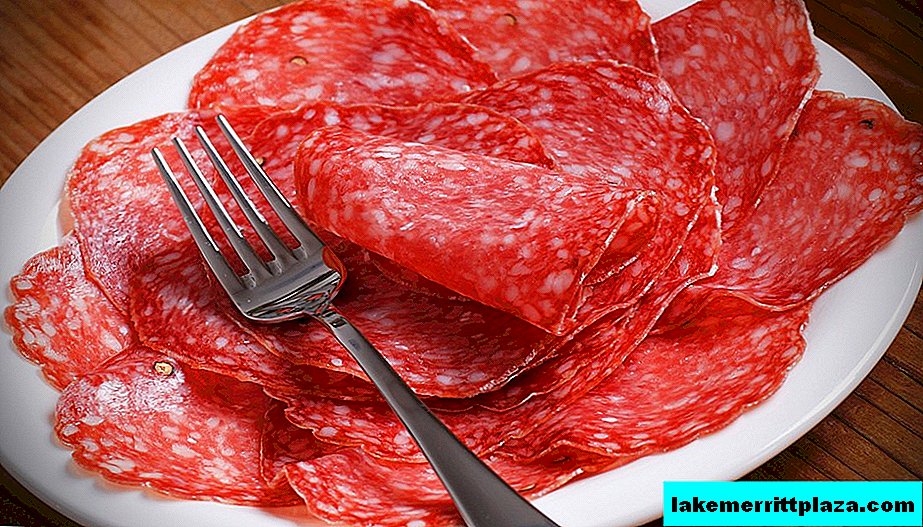
Salami Milano is not a member of the DOP and IGP categories. However, it is one of the most famous varieties among Italian salami. It is made from a mixture of finely ground pork and beef, which is seasoned with salt and a small amount of seasoning and stuffed in a natural or synthetic shell. The exposure time is about 3 months. The color of the cut is bright red, almost ruby. The taste is delicate. Served with milano salami in a meat plate. Milanese eat it with traditional michetta bread.
Origin
The history of salami in the territory of modern Italy began in the period of the Roman Empire. The name of the product comes from the Latin word salumen, but it appears only in the Middle Ages and means that the product is stored with salt. So called not only meat, but also fish. However, over time, the term “salami” has been increasingly associated with pork.
Although the first attempts to preserve meat and salt for a long time belong to the history of prosciutto, in rural areas the way of packing ground meat into animal guts began to dominate faster.
The mass production of salami begins in the Middle Ages, when the first large pigsties appeared in the immediate vicinity of milk processing sites. Waste from the production of cheese and cottage cheese is ideal for feed pigs. The birth of such an industry and Italy's unique microclimate creates ideal conditions for the spread of the art of meat storage. In Milan, minced pork was mixed with wine and spices. Such salami were sent to the ceremonial tables of nobles and feudal lords.
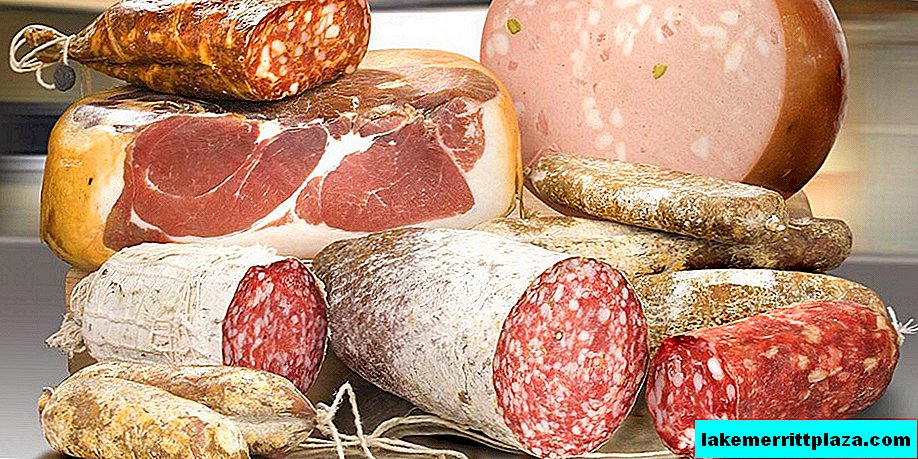
In the XII century, at the courtyard of the Malaspin family, they served a “new” sausage aged in wine cellars and “aromatized” with smoke. And in 1581 the word "salame" first appears in the cookbook and indicates pork sausage. Prior to this, sausages were designated by the term insicia. Later, salami goes to the tables of rural residents, when raising pigs becomes an indispensable resource for survival.
The art of making salami evolved differently depending on the region of Italy. Which inevitably led to a variety of varieties of Italian salame even in the same region.
Production
The quality of Italian salami is supported not only in the production hall. Even the territory and feed for raising pigs, whose meat is used in the preparation of sausages, are regulated. For slaughter go animals weighing 160-180 kg. The basis of their diet is cereals and by-products of milk processing. As a result of such nutrition, raw materials are rich in saturated fatty acids and have low cholesterol.
Salami, however, may contain not only pork, but also the meat of sheep, goats, horses, geese, donkeys, wild boars and their offal. Although the fatty part is taken only from pigs because of its organoleptic properties.
Before starting cooking, the veins and adipose tissue are removed from the meat. It is thoroughly cleaned and cooled to a temperature of 7 degrees. Which parts of the carcass are used to make salami, as well as the fineness of grinding, depend on the type of sausage.
Salt and spices are added to the minced meat, the presence of which is determined by the type of product. Of the spices used garlic, black and white pepper (ground or in grains), dill, nutmeg, cloves and others. In some regions of Italy, unusual salami are found. For example, with walnuts or pistachios. A non-standard method can be called adding milk or wine to raw materials. The law allows the use of sodium nitrite as a dye and a weak preservative.
The sausage dough is stuffed with a natural (pig, sheep, cattle and horse gut) or synthetic (cellulose) casing. For preliminary drying, the sausage is sent to warm rooms for 3-7 days. Further ripening occurs at a temperature of 10-15 degrees. Exposure times vary by grade. The final stage of preparation for certain types of salami may be slightly smoked to give a specific flavor.
Calorie content and benefits
The calorie content of salami, like other products, directly depends on its variety. It is not possible to consider everything, so we will focus on Salami Milano - the most famous and bought Italian sausage in the world. The number of calories per 100 g is 384 kcal, which are composed of:
- Proteins 25.4 g (101.4 kcal);
- Fats 31 g (278.4 kcal);
- Carbohydrates 1.1 g (4.2 kcal).
Salami Milano is a product with high energy value. Nevertheless, lard in it is easily absorbed due to the development of beneficial microflora during the ripening of sausage.
Pork meat is very rich in protein, which is necessary as a building component for the human body. In addition, the fermentation of proteins during the aging of the product leads to better absorption.
In addition, sausages are one of the important sources of bioavailable iron, zinc and other minerals. Salami is rich in vitamins B1 and B3. They participate in the metabolism, ensure the normal functioning of the nervous and cardiovascular systems, as well as the digestive system.
Salami is recommended for nutrition to people with reduced weight and lack of appetite, during periods of mental and physiological stress, during recovery. If you do not belong to any category, but love salami, you should be aware that you can spend calories from 100 g of salami:
- Cleaning the house for 2.5 hours;
- Brisk walking 1 hour;
- Running at an average speed of 27 minutes;
- Playing football 34 minutes;
- Swimming 40 minutes.
The disadvantage of the product is the high content of sodium chloride (salt), the excessive use of which contributes to the formation of arterial hypertension.
Homemade recipe
Often, home lovers of culinary feats stop at the most exotic and irresistible options. One of them can be called salami. If you search for her recipe at home on Italian sites, then at best you will find a way to make sweet sausages for dessert.
We will share with you a simple recipe for homemade sausage. But, in fairness, we note that it is impossible to cook real Italian salami in your kitchen. So, we need:
- Pork - 850 g;
- Fat - 150 g;
- Salt - 25 g;
- Dry wine - 10 ml;
- Pepper - 5 g;
- Garlic - 5 cloves;
- Spices to taste;
- Pork intestines.
The spices in the recipe can be used in a variety of ways (cloves, nutmeg, ginger, etc.). It all depends on your taste. The guts are usually sold clean, but still they should be washed additionally under running water. Why do we take pork? They are optimal in diameter.
Grind lard (slices 10 mm thick) and meat (small cubes). We send the pork to the freezer for a while, until it freezes slightly (but does not freeze). We twist the meat in a meat grinder with a large diameter of the holes, and finely chop the fat manually.
Add salt, wine and spices to the mass, mix thoroughly. Using the sausage nozzle, fill the intestines with minced meat. We make constricts along the length for the formation of sausages. Carefully inspect the resulting sausage for air bubbles. If any, then they must be pierced.
Wrap the sausages with twine and hang in a cool room with low humidity for about 7 days. During this time, the product will lose some moisture and acquire the necessary consistency.
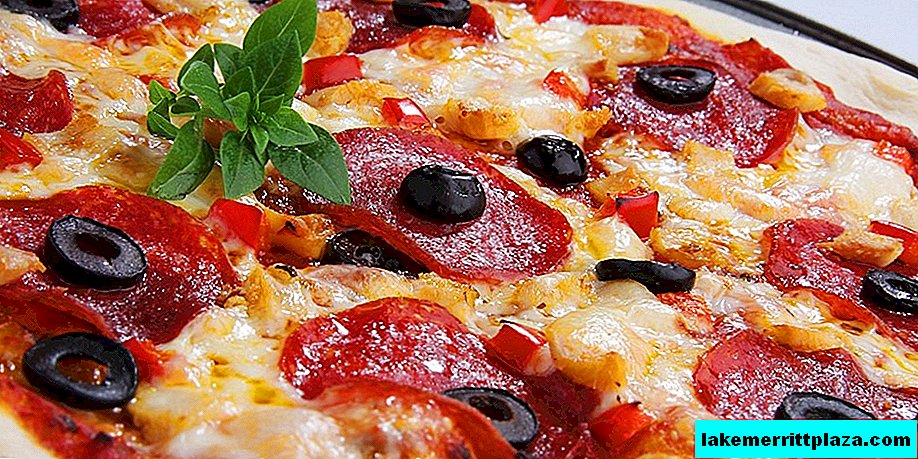
Cooked sausage "ala salami" must be stored in the refrigerator. It will be a great snack for alcoholic drinks. You can also cook salami pizza by adding cheese, tomatoes, olives, bell peppers, onions and slices of your homemade masterpiece.
Price
To conquer Italy and acquire salami at the same time is a rather interesting option for a vacation. Moreover, you can find it easily, with little or no effort. Famous salami milano in her homeland can be purchased at a price of 12 to 25 euros per 1 kg.
Domestic stores offer 1 kg of Italian product for 3000-3500 rubles. Russian-made products with the name "Salami Milano" are estimated at 1,500 rubles per 1 kg.

Not a sad story about salami came to an end. Eating a piece of sausage with crispy bread and then jogging around the Coliseum seems like the perfect start to the day. Live light, love secretly, travel deliciously and remember: "They don’t go to Italy with their salami!"






